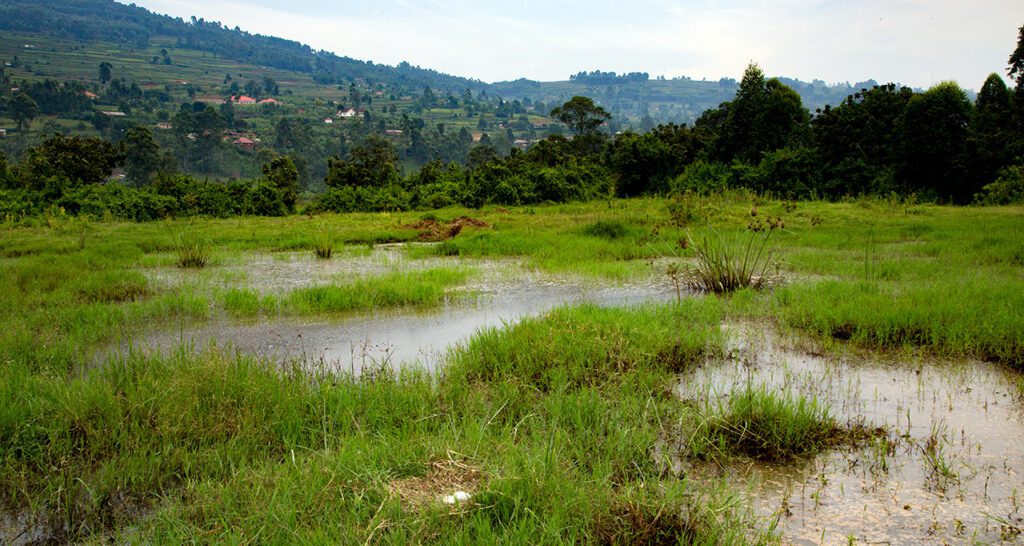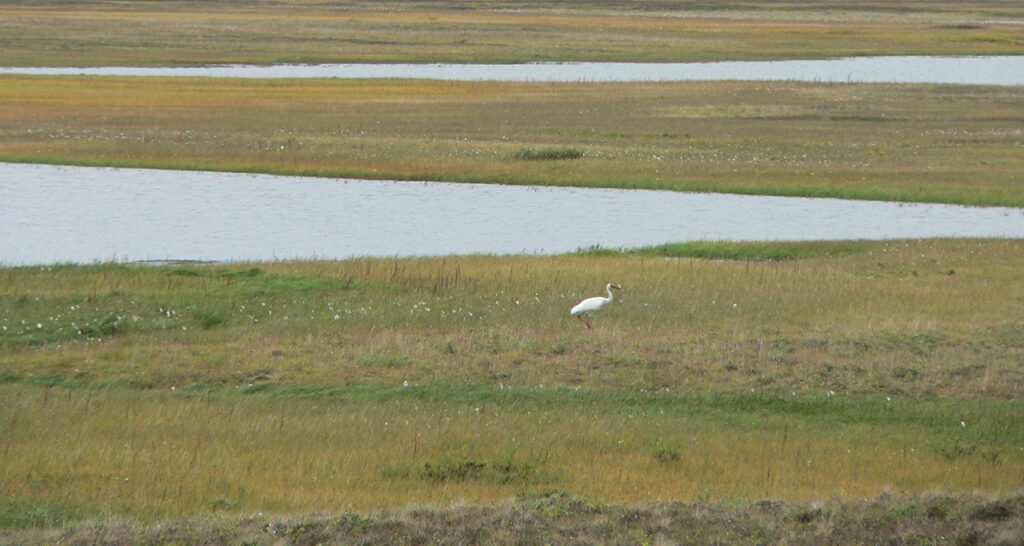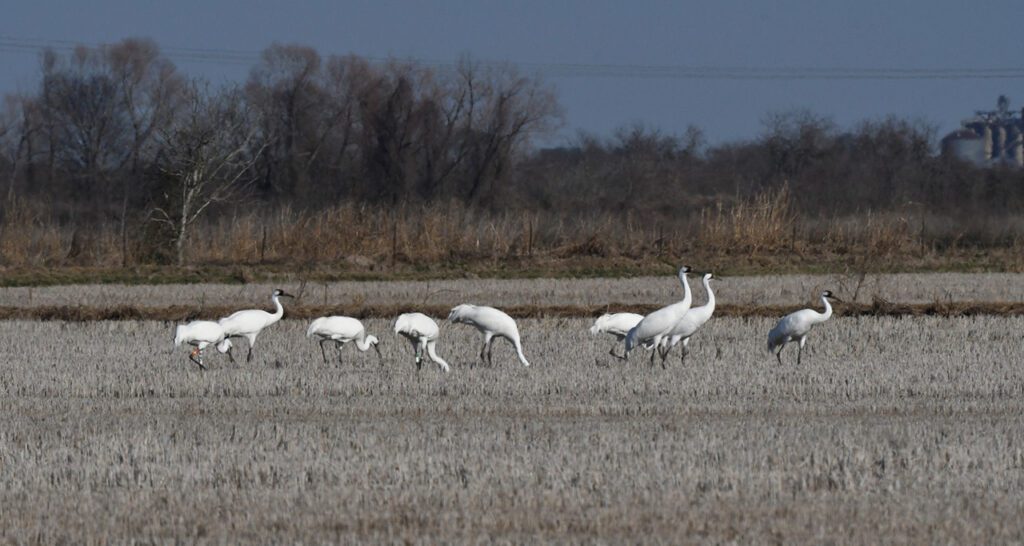Cranes Take Flight at the IUCN World Conservation Congress
Field Notes from the President
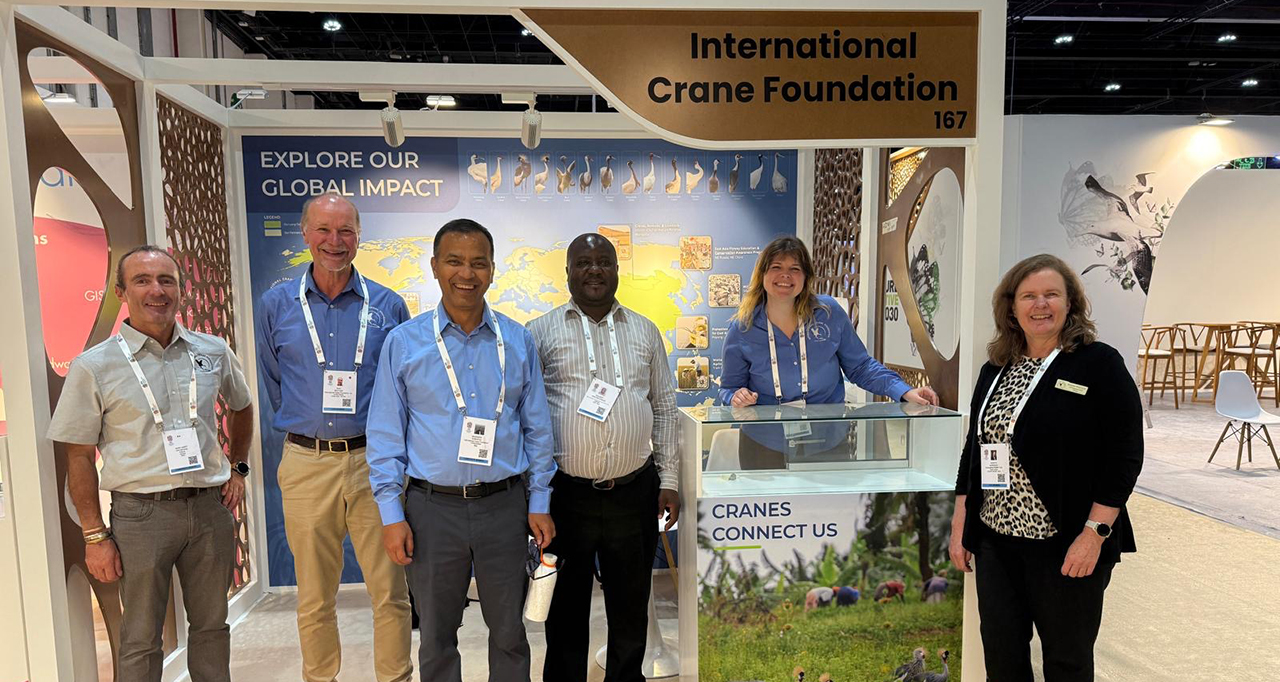
Our team is ready for the Congress! Pictured from left to right: Deputy Director of Africa Programs Mark van Niekerk, President and CEO Dr. Rich Beilfuss, Vice President-Asia Programs Dr. Mahendra Shrestha, East Africa Regional Director Dr. Adalbert Aine-Omucunguzi, Graphics and Video Production Specialist Hannah Jones, and Vice President-Africa Programs Kerryn Morrison
Oct. 9, 2025—Today was the grand opening of the World Conservation Congress in Abu Dhabi, United Arab Emirates. The Congress is held once every four years and brings together 10,000 government leaders, indigenous community members, philanthropists, and conservation leaders from more than 150 countries worldwide.
I am joined by our Vice President-Asia Programs Dr. Mahendra Shrestha, Vice President-Africa Programs Kerryn Morrison, Deputy Director of Africa Programs Mark van Niekerk, and East Africa Regional Director Dr. Adalbert Aine-Omucunguzi. We are spreading ourselves across more than 500 sessions this week, seeking to learn from others and share our experience in community-centered conservation of cranes, wetlands, and much more. The International Crane Foundation’s Graphics and Video Production Specialist, Hannah Jones, is anchoring our beautiful display booth.
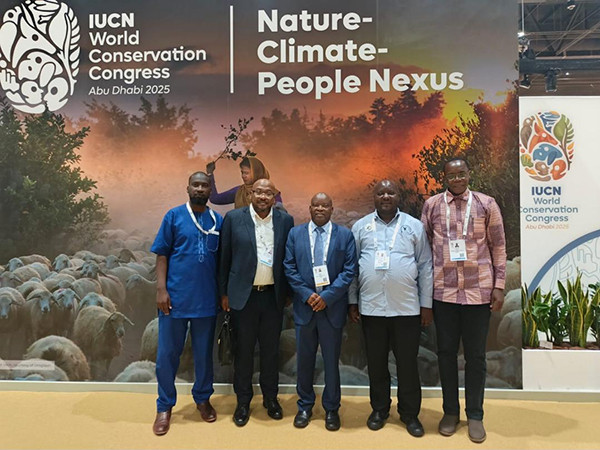
Our East Africa Regional Director, Dr. Adalbert Aine-omucunguzi (second from right), with the Africa Union Commissioner for Agriculture, Rural Development, Blue Economy, and Sustainable Environment.
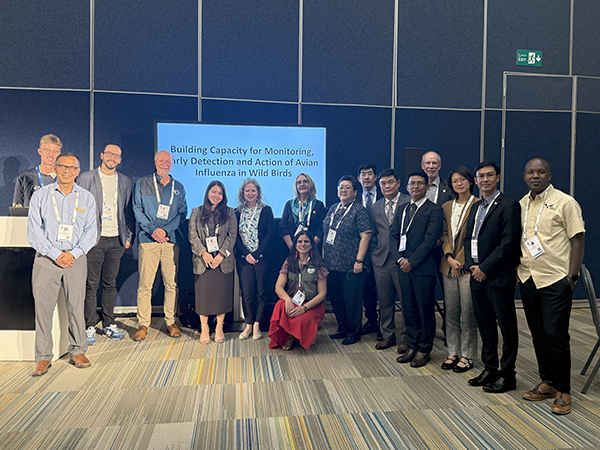
The International Crane Foundation hosted a session today on monitoring, early detection, and action for combating bird flu in wild bird populations.
There were many great sessions today, covering strategies for scaling up our conservation impact, linking biodiversity conservation with safe water, food security, and human health as “One Health,” and new funding pathways for conservation. We look forward to a great week ahead!
Oct. 10, 2025—Another inspiring day at the World Conservation Congress with our team! Some of the key issues we are grappling with here include how to integrate our deep work with communities on agricultural lands into the global effort to protect 30% of the earth by 2030. Cranes, and so much of our global biodiversity, depend on areas that have been converted from natural areas to agricultural lands over the past century, and these areas now hold a very rich biodiversity that is also highly vulnerable to human disturbance, agrochemicals, and other challenges. We work with these communities to promote sustainable livelihoods, climate-smart agriculture, diversified buffer zones, best wetland management practices, and other initiatives.
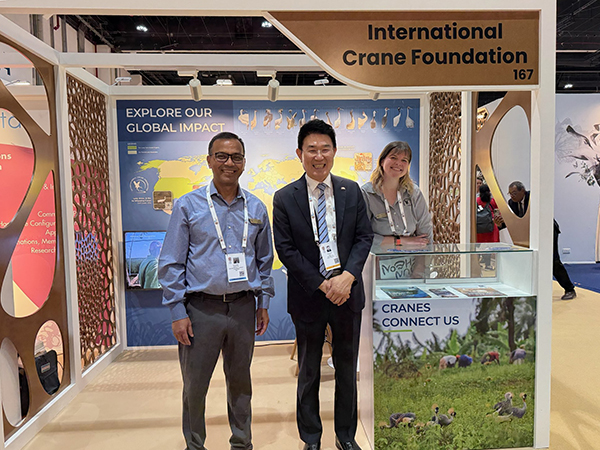
Dr. Mahendra Shrestha and Hannah Jones with Mayor Noh Kwan-kyu
We were also delighted to meet Mayor Noh Kwan-kyu of Suncheon City, South Korea. Mayor Noh has turned Suncheon into the “ecological capital of Korea” and a globally recognized eco-city, which places major emphasis on conservation and sustainable tourism for the Hooded Cranes that winter there. Last January, we traveled to Suncheon with our entire International Crane Foundation Board of Directors and senior leadership team to meet with the Mayor and his team and praise their remarkable efforts to transform Suncheon into a global model for sustainability.
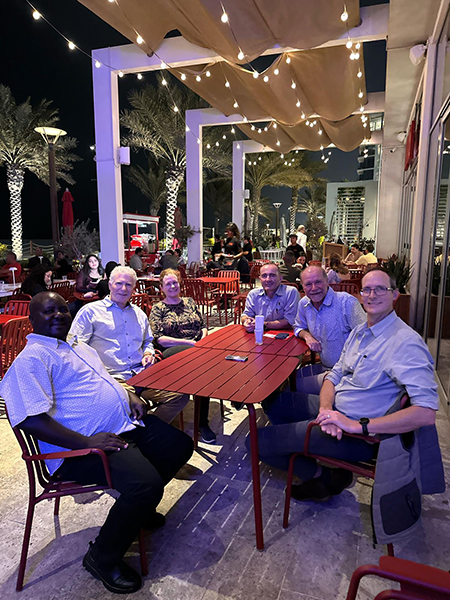
In the evening, we enjoyed a dinner meeting with Mark Gerard and David Meyer of the Conservation Strategy Foundation. We are working together this year to develop innovative new conservation finance tools to support our work in Africa, Asia, and North America.
Oct. 11, 2025—Despite the more than 500 sessions at the World Conservation Congress this year, the most important value of this event is networking with colleagues worldwide. It was great today to reconnect with Dr. Musonda Mumba—we worked together 20 years ago when she completed her PhD on the Kafue Flat—and today she has ascended to the position of Secretary General of the Ramsar Convention on Wetlands. We enjoyed discussing all the progress we’ve made on the Kafue Flats in the past 20 years and the challenges ahead. Musonda is in a key position to help us engage the Zambian government to reduce mining pressure and other threats to the Kafue Flats. She is also connected to government and policy leaders in the Central Asia flyway, where we need strong political support to reduce hunting pressure on Demoiselle Cranes.
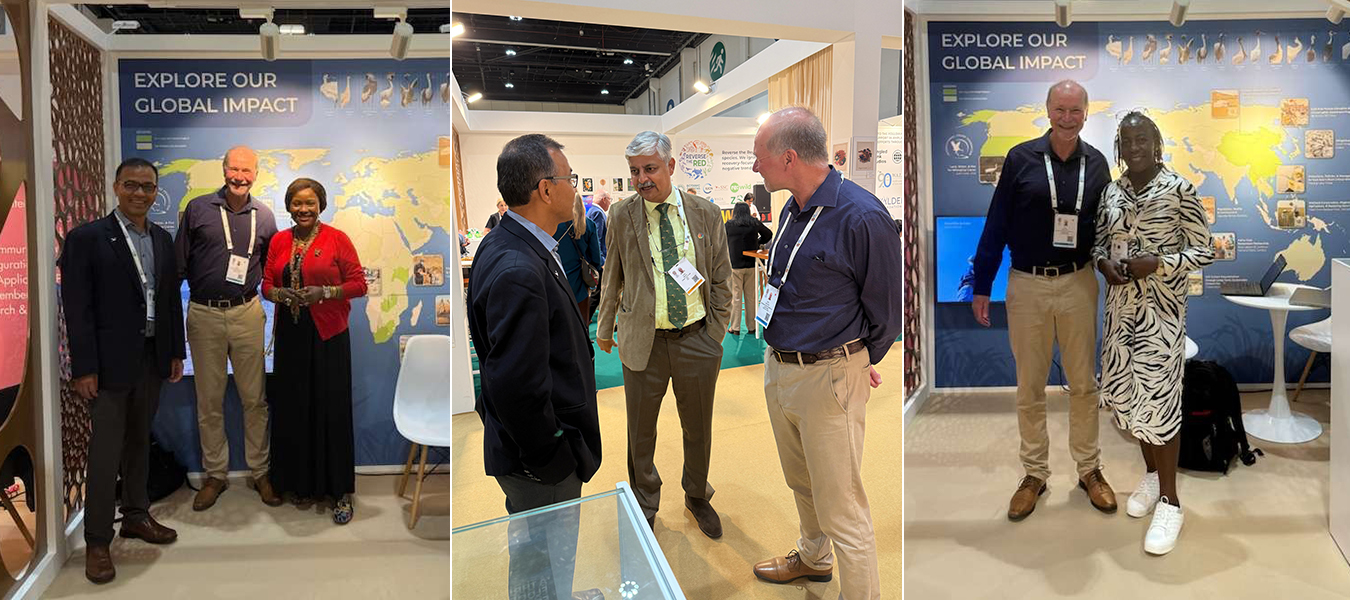
Mahendra and Rich with Dr. Musonda Mumba, Secretary General of the Ramsar Convention on Wetlands, Dr. Vivet Menon, incoming chair of the IUCN Species Survival Commission, and Doreen Simiyu from the Community Action for Nature Conservation in Kenya.
We enjoyed hosting many other important colleagues at our booth too, including the incoming chair of the IUCN Species Survival Commission Dr. Vivek Menon, Ms. Doreen Simiyu from Community Action for Nature Conservation (CANCO), our long-term partner in Kenya, Dr. Noheri Jean Bosco from the Rwanda Wildlife Conservation Association, Mr. Ochirkhuyag Jargalsaikhan from the Mongolian Nature Legacy Society, Dr. Munir Virani from the Mohammed Bin Zayed Species Conservation Fund, Dr. Nick Salafasky from Foundations of Success—an organization dedicating to helping organizations measure and scale-up their conservation impact—, long-time friends from the Bhutan Royal Society for the Protection of Nature, and many others. Cranes are such wonderful ambassadors for connecting the global conservation community.
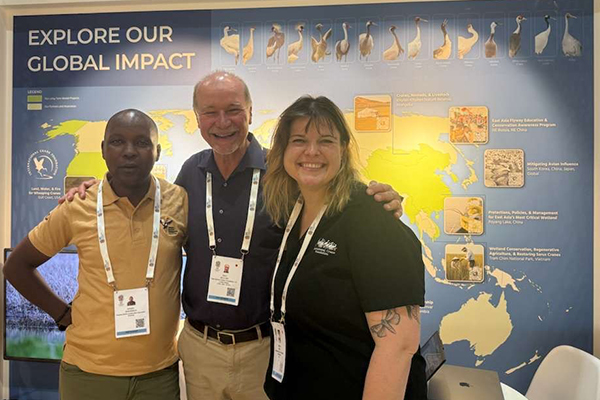
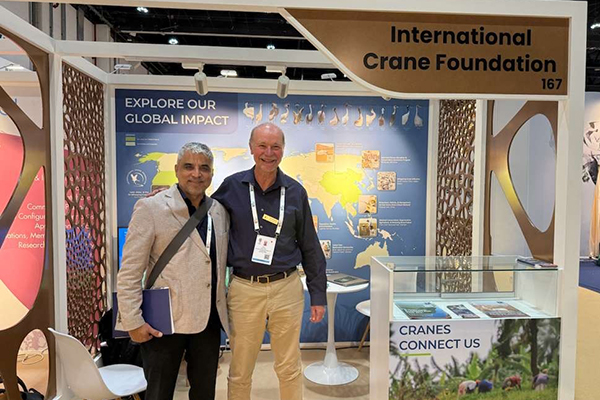
Top: Noheri Bosco from the Rwanda Wildlife Conservation Association with Rich and Hannah. Above: Munir Virana from the Mohammed Bin Zayed Species Conservation Fund and Rich.
Oct. 12, 2025—On our fourth day together at the World Conservation Congress, we continued to focus on the congress’s overarching themes. We explored ways to best elevate the impact of our model conservation projects in Asia, Africa, and North America to the world stage. One of the key themes that has resonated for us here is the power of multilateralism (global cooperation among countries) to solve big problems in a polarized world. We’ve long championed cranes as ambassadors for bringing together governments and cultures across borders to ensure safe flyways for migratory birds, and we all know that global engagement is essential to solving big, intractable problems like climate change, water security, and biodiversity loss. Other important themes here include the need for stronger attention to freshwater conservation, the advance of new conservation finance tools to increase the overall investment in biodiversity and sustainable development solutions, improved pathways to scale up our impacts to cover broader areas and affect needed behavior changes more widely, and new “One Health” strategies that recognize the interdependence of people, domestic and wild animals, and the natural environment.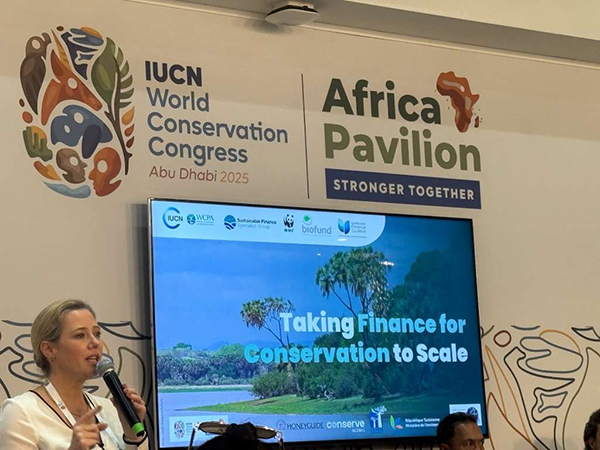
A particularly important niche for the International Crane Foundation is to ensure that community-based conservation projects, whether focused on One Health, freshwater conservation, or other strategies for human development and well-being, also deliver clear, positive impacts “on the ground” for cranes and other rare and threatened species. As world leaders scramble collectively to protect 30% of the earth’s lands and waters by 2030 (the so-called 30 x 30 pledge), the International Crane Foundation is an important voice for ensuring that we focus not only on big new protected areas like national parks and nature reserves, but also the working lands shared by people and wildlife—like farms and floodplains. These working lands provide a wealth of ecosystem services to communities and nations, as well as critical habitat for many species that have been displaced from more natural areas. In some of the countries where we work, agricultural lands support a greater diversity of wildlife than adjacent protected areas. Our long-term commitment to these working lands and communities has never been stronger.
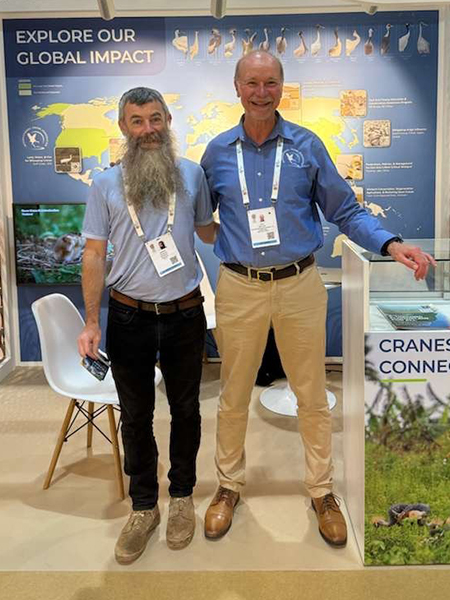
It was my first time meeting Andrew Scanlon of BraveEarth Afghanistan. He has been a friend of the International Crane Foundation for many years and was recently very helpful in securing asylum status for one of our staff members.
Oct. 13, 2025—As the final sessions of World Conservation Congress wind down, attention turns to another key role of this gathering—to debate and approve motions that call for decisive government action on conservation threats and opportunities worldwide. Before the congress, we voted online on 97 motions and an additional 40 motions were discussed in session here. In past years, the International Crane Foundation, as a long-standing member of the World Conservation Union, has put forward motions aimed at increasing government support to stop the illegal trade of cranes, promoting biodiversity conservation on agricultural lands, and reducing the impact of water resources development on the great Poyang Lake in China.
We also commit to new and ongoing International Crane Foundation roles with the World Conservation Congress for the next quadrennium (2025-2029). Kerryn Morrison and I will serve as co-chairs of the IUCN Crane Specialist Group under the Species Survival Commission, which brings together specialists concerned with cranes and crane landscapes from more than 50 countries worldwide. Our staff also serve on a range of other commissions, including the World Commission on Protected Areas, the Commission on Environmental, Economic, and Social Policy, and the Commission on Ecosystem Management. Dr. Adalbert Aine-Omucunguzi of our team will serve again as the East Africa Regional Representative to the World Conservation Union.
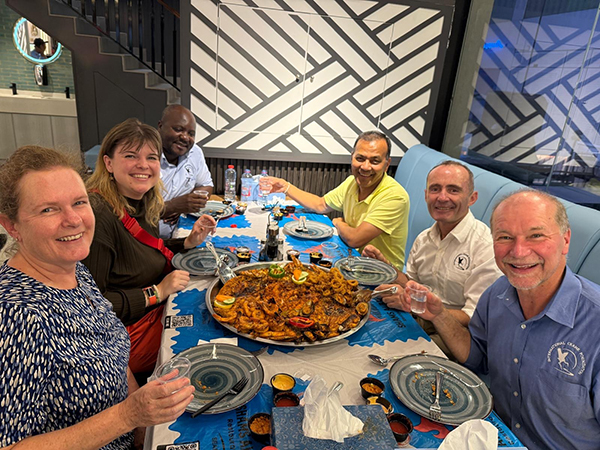
The team taking a well-earned break before heading back to their respective homes.
My final reflection on the 2025 World Conservation Congress is that the International Crane Foundation is doing some of the most important community-based conservation work on the ground. We carefully prioritize our investments and do not seek to work everywhere. Still, where we focus, we deliver high-impact results for cranes, wetlands, and communities, and we earn very strong support from the communities and governments we serve. Over the coming four years until the next World Conservation Congress, we will continue to take bold action, learn and adapt, and grow our projects and programs to serve as global models for doing conservation right.

Dr. Rich Beilfuss,
President and CEO, International Crane Foundation
